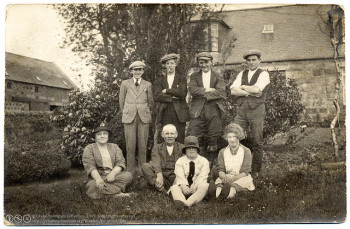Sandwiched in between a decade of war and a decade of depression you could have forgiven fashion for taking a break in the 1920s. You could have understood if fashion had just wanted to have a nice, easy time, maybe introduce a new style of sock if business was especially slow, but nothing revolutionary. And for the first few years of the decade that is effectively what happened (not the invention of a new type of sock unfortunately, that would have deserved an article in The Linc all to itself).
Change was slow. Suit jackets with very high waists and slim lapels were fashionable in the early 1920s, seemingly copied from the style of military uniforms. Men’s fashion looked back to the past, and especially to the First World War, more than it might have cared to admit.

Trousers suffered from the same problem. The peg-top craze was as dead as the Red Scare and trousers had returned to being relatively straight and narrow. Even though they were being cuffed at the bottom in an attempt to seem ‘hip’, nobody was being fooled. The Roaring Twenties hadn’t penetrated fashion quite as much or quite as quickly as we all think it did.
1925 was the turning point, the year that Oxford bags saved the West. They were hardly revolutionary, being just very baggy trousers, sometimes measuring up to 40 inches wide at the waist. But they were just the thing needed to kick the 20s out of its war-depressed slump and into the dynamic age for fashion it’s become famous for.
Highly formal attire that would be worn daily weren’t as popular anymore: suits lost weight by being made with lighter materials, whilst jackets lost their tailcoats and started shrinking. The short tuxedo was preferred for formal evening occasions.

Clothing styled on athletics also began to find favour with a lot of men, leading to jumpers and short pants that stopped at the knee, hilariously known as knickers. Take your time getting over that dandy little bit of comedy, because you’ll need to prepare yourself for the next shocking reveal.
Shirts were done being boring and plain and started loosening up. Picture a stuffy white shirt unbuttoning itself after a hard decade’s work, pouring itself an apple martini and hitting the town and you’re pretty much there. Shirts of the 1920s needed colourful stripes – greens, yellows, blues, even pinks. Gatsby wore a pink rag of a suit and nobody looked at him funny. Collarless shirts, called Grandad shirts, were well-received too.
Accessories were also the other bit of colour men of the decade could have fun with. Bow ties were deemed cool and came in stripes or polka dots, and short, thin neckties would often have an art deco inspired pattern. Men started favouring bright yellow or red gloves over black or brown. With their vibrant colours and cool dismissal of traditional styles, accessories jumped out and invited you to do shots with them.
Even the shoes were a little bit mad! Two-tone lace-up oxfords were all the rage, and as the decade went on the design of the wingtips started getting more ostentatious.
Widely seen as one of the most exciting periods of the 20th century, the 1920s had a huge impact on men’s fashion, to the extent that men’s suits today are still for the most part based on those worn in the latter half of the decades. Next month see how men’s fashion fared in the 1930s.

